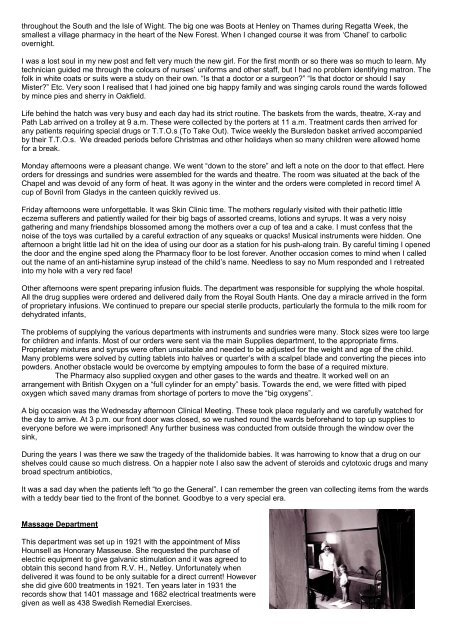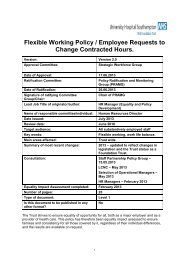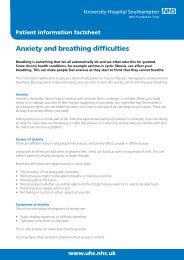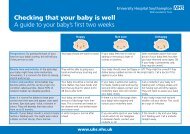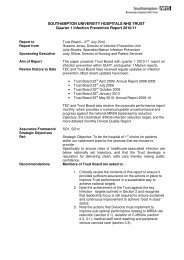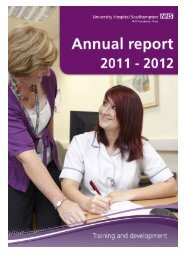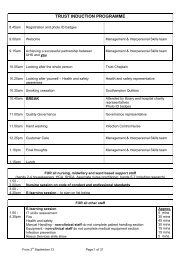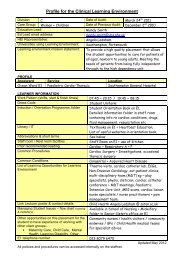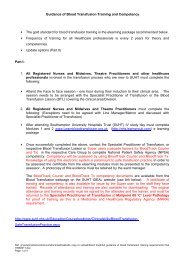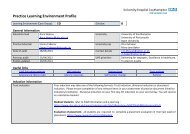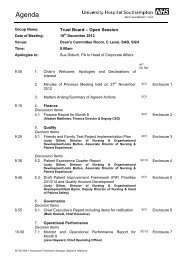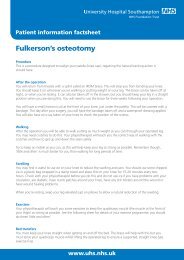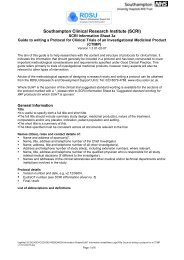ninety years of service - University Hospital Southampton NHS ...
ninety years of service - University Hospital Southampton NHS ...
ninety years of service - University Hospital Southampton NHS ...
- No tags were found...
Create successful ePaper yourself
Turn your PDF publications into a flip-book with our unique Google optimized e-Paper software.
throughout the South and the Isle <strong>of</strong> Wight. The big one was Boots at Henley on Thames during Regatta Week, thesmallest a village pharmacy in the heart <strong>of</strong> the New Forest. When I changed course it was from ‘Chanel’ to carbolicovernight.I was a lost soul in my new post and felt very much the new girl. For the first month or so there was so much to learn. Mytechnician guided me through the colours <strong>of</strong> nurses’ uniforms and other staff, but I had no problem identifying matron. Thefolk in white coats or suits were a study on their own. “Is that a doctor or a surgeon?” “Is that doctor or should I sayMister?” Etc. Very soon I realised that I had joined one big happy family and was singing carols round the wards followedby mince pies and sherry in Oakfield.Life behind the hatch was very busy and each day had its strict routine. The baskets from the wards, theatre, X-ray andPath Lab arrived on a trolley at 9 a.m. These were collected by the porters at 11 a.m. Treatment cards then arrived forany patients requiring special drugs or T.T.O.s (To Take Out). Twice weekly the Bursledon basket arrived accompaniedby their T.T.O.s. We dreaded periods before Christmas and other holidays when so many children were allowed homefor a break.Monday afternoons were a pleasant change. We went “down to the store” and left a note on the door to that effect. Hereorders for dressings and sundries were assembled for the wards and theatre. The room was situated at the back <strong>of</strong> theChapel and was devoid <strong>of</strong> any form <strong>of</strong> heat. It was agony in the winter and the orders were completed in record time! Acup <strong>of</strong> Bovril from Gladys in the canteen quickly revived us.Friday afternoons were unforgettable. It was Skin Clinic time. The mothers regularly visited with their pathetic littleeczema sufferers and patiently wailed for their big bags <strong>of</strong> assorted creams, lotions and syrups. It was a very noisygathering and many friendships blossomed among the mothers over a cup <strong>of</strong> tea and a cake. I must confess that thenoise <strong>of</strong> the toys was curtailed by a careful extraction <strong>of</strong> any squeaks or quacks! Musical instruments were hidden. Oneafternoon a bright little lad hit on the idea <strong>of</strong> using our door as a station for his push-along train. By careful timing I openedthe door and the engine sped along the Pharmacy floor to be lost forever. Another occasion comes to mind when I calledout the name <strong>of</strong> an anti-histamine syrup instead <strong>of</strong> the child’s name. Needless to say no Mum responded and I retreatedinto my hole with a very red face!Other afternoons were spent preparing infusion fluids. The department was responsible for supplying the whole hospital.All the drug supplies were ordered and delivered daily from the Royal South Hants. One day a miracle arrived in the form<strong>of</strong> proprietary infusions. We continued to prepare our special sterile products, particularly the formula to the milk room fordehydrated infants,The problems <strong>of</strong> supplying the various departments with instruments and sundries were many. Stock sizes were too largefor children and infants. Most <strong>of</strong> our orders were sent via the main Supplies department, to the appropriate firms.Proprietary mixtures and syrups were <strong>of</strong>ten unsuitable and needed to be adjusted for the weight and age <strong>of</strong> the child.Many problems were solved by cutting tablets into halves or quarter’s with a scalpel blade and converting the pieces intopowders. Another obstacle would be overcome by emptying ampoules to form the base <strong>of</strong> a required mixture.The Pharmacy also supplied oxygen and other gases to the wards and theatre. lt worked well on anarrangement with British Oxygen on a “full cylinder for an empty” basis. Towards the end, we were fitted with pipedoxygen which saved many dramas from shortage <strong>of</strong> porters to move the “big oxygens”.A big occasion was the Wednesday afternoon Clinical Meeting. These took place regularly and we carefully watched forthe day to arrive. At 3 p.m. our front door was closed, so we rushed round the wards beforehand to top up supplies toeveryone before we were imprisoned! Any further business was conducted from outside through the window over thesink,During the <strong>years</strong> I was there we saw the tragedy <strong>of</strong> the thalidomide babies. It was harrowing to know that a drug on ourshelves could cause so much distress. On a happier note I also saw the advent <strong>of</strong> steroids and cytotoxic drugs and manybroad spectrum antibiotics,It was a sad day when the patients left “to go the General”. I can remember the green van collecting items from the wardswith a teddy bear tied to the front <strong>of</strong> the bonnet. Goodbye to a very special era.Massage DepartmentThis department was set up in 1921 with the appointment <strong>of</strong> MissHounsell as Honorary Masseuse. She requested the purchase <strong>of</strong>electric equipment to give galvanic stimulation and it was agreed toobtain this second hand from R.V. H., Netley. Unfortunately whendelivered it was found to be only suitable for a direct current! Howevershe did give 600 treatments in 1921. Ten <strong>years</strong> later in 1931 therecords show that 1401 massage and 1682 electrical treatments weregiven as well as 438 Swedish Remedial Exercises.


